Gender and Islam: Examining Societal and Religious Views
VerifiedAdded on 2023/03/30
|9
|2414
|148
Essay
AI Summary
This essay delves into the complex interplay of gender dynamics within Islam, examining the viewpoints of various scholars. It begins by introducing the historical and sociological context of religion, particularly the patriarchal structures often associated with Abrahamic faiths. The essay then focuses on the specific case of Islam, analyzing the perspectives of Edward Said, Fatima Mernissi, and Fadela Amara. It explores the debate surrounding veiling, challenging Western feminist narratives and examining how Muslim feminists view the practice. The essay also analyzes Mernissi's Freudian analysis of sexuality in Islam and Amara's views on the hijab and masculinity in the West. Through these analyses, the essay aims to provide a nuanced understanding of the diverse perspectives on gender roles and societal expectations within Islamic contexts, highlighting the complexities and contradictions inherent in these discussions. The assignment is a student contribution on Desklib, the platform provides all the necessary AI based study tools for students.

Running head: GENDER AND ISLAM
GENDER AND ISLAM
Name of the Student
Name of the University
Author Note
GENDER AND ISLAM
Name of the Student
Name of the University
Author Note
Paraphrase This Document
Need a fresh take? Get an instant paraphrase of this document with our AI Paraphraser
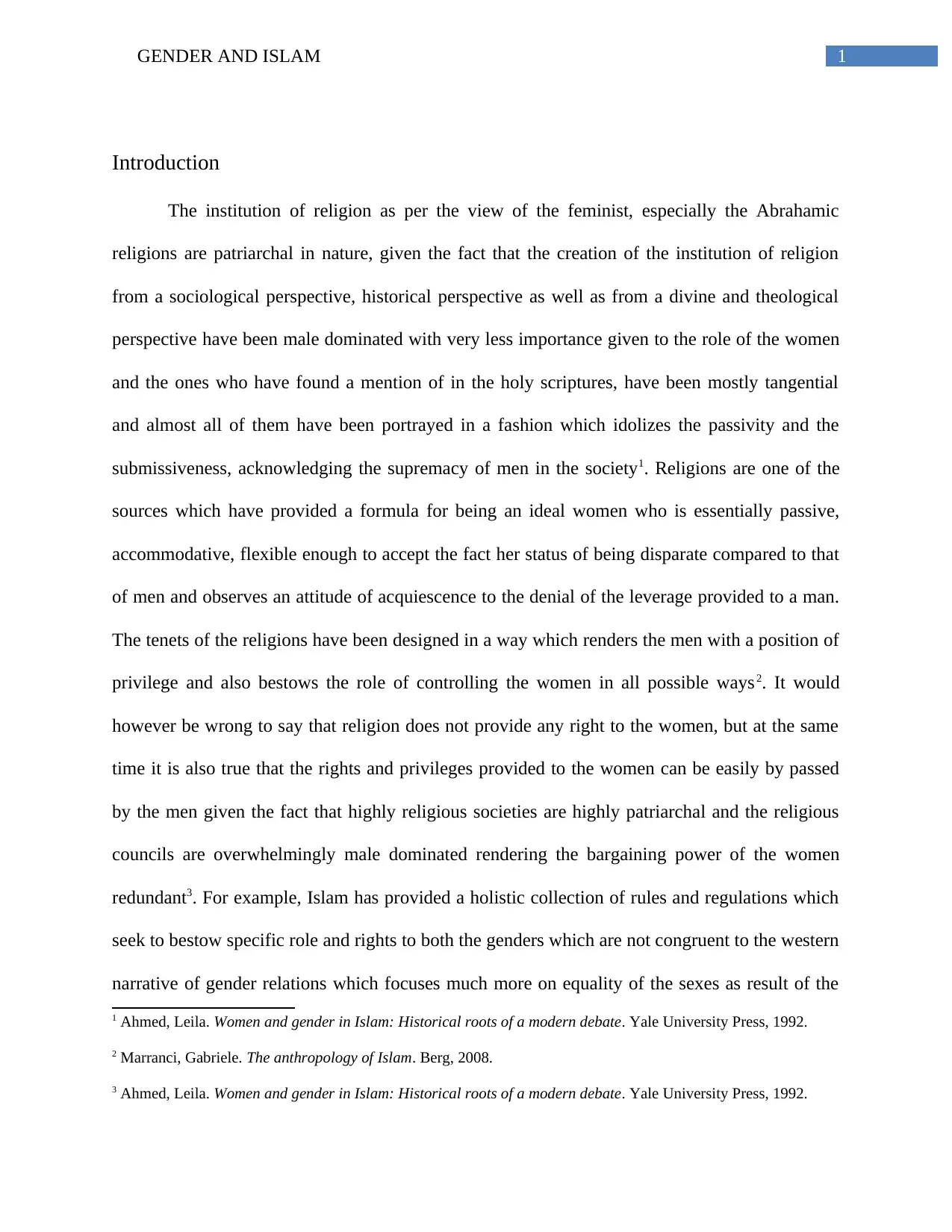
1GENDER AND ISLAM
Introduction
The institution of religion as per the view of the feminist, especially the Abrahamic
religions are patriarchal in nature, given the fact that the creation of the institution of religion
from a sociological perspective, historical perspective as well as from a divine and theological
perspective have been male dominated with very less importance given to the role of the women
and the ones who have found a mention of in the holy scriptures, have been mostly tangential
and almost all of them have been portrayed in a fashion which idolizes the passivity and the
submissiveness, acknowledging the supremacy of men in the society1. Religions are one of the
sources which have provided a formula for being an ideal women who is essentially passive,
accommodative, flexible enough to accept the fact her status of being disparate compared to that
of men and observes an attitude of acquiescence to the denial of the leverage provided to a man.
The tenets of the religions have been designed in a way which renders the men with a position of
privilege and also bestows the role of controlling the women in all possible ways2. It would
however be wrong to say that religion does not provide any right to the women, but at the same
time it is also true that the rights and privileges provided to the women can be easily by passed
by the men given the fact that highly religious societies are highly patriarchal and the religious
councils are overwhelmingly male dominated rendering the bargaining power of the women
redundant3. For example, Islam has provided a holistic collection of rules and regulations which
seek to bestow specific role and rights to both the genders which are not congruent to the western
narrative of gender relations which focuses much more on equality of the sexes as result of the
1 Ahmed, Leila. Women and gender in Islam: Historical roots of a modern debate. Yale University Press, 1992.
2 Marranci, Gabriele. The anthropology of Islam. Berg, 2008.
3 Ahmed, Leila. Women and gender in Islam: Historical roots of a modern debate. Yale University Press, 1992.
Introduction
The institution of religion as per the view of the feminist, especially the Abrahamic
religions are patriarchal in nature, given the fact that the creation of the institution of religion
from a sociological perspective, historical perspective as well as from a divine and theological
perspective have been male dominated with very less importance given to the role of the women
and the ones who have found a mention of in the holy scriptures, have been mostly tangential
and almost all of them have been portrayed in a fashion which idolizes the passivity and the
submissiveness, acknowledging the supremacy of men in the society1. Religions are one of the
sources which have provided a formula for being an ideal women who is essentially passive,
accommodative, flexible enough to accept the fact her status of being disparate compared to that
of men and observes an attitude of acquiescence to the denial of the leverage provided to a man.
The tenets of the religions have been designed in a way which renders the men with a position of
privilege and also bestows the role of controlling the women in all possible ways2. It would
however be wrong to say that religion does not provide any right to the women, but at the same
time it is also true that the rights and privileges provided to the women can be easily by passed
by the men given the fact that highly religious societies are highly patriarchal and the religious
councils are overwhelmingly male dominated rendering the bargaining power of the women
redundant3. For example, Islam has provided a holistic collection of rules and regulations which
seek to bestow specific role and rights to both the genders which are not congruent to the western
narrative of gender relations which focuses much more on equality of the sexes as result of the
1 Ahmed, Leila. Women and gender in Islam: Historical roots of a modern debate. Yale University Press, 1992.
2 Marranci, Gabriele. The anthropology of Islam. Berg, 2008.
3 Ahmed, Leila. Women and gender in Islam: Historical roots of a modern debate. Yale University Press, 1992.
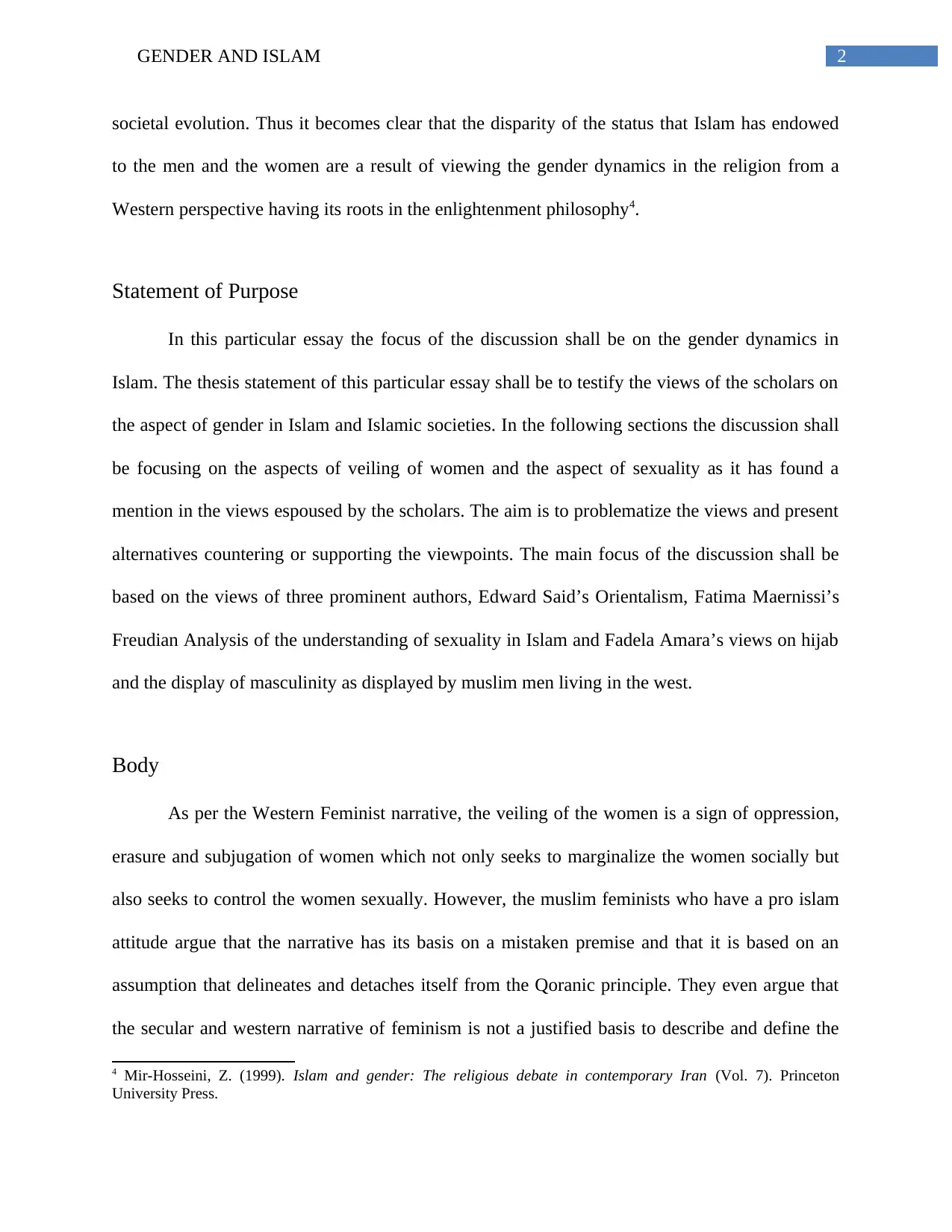
2GENDER AND ISLAM
societal evolution. Thus it becomes clear that the disparity of the status that Islam has endowed
to the men and the women are a result of viewing the gender dynamics in the religion from a
Western perspective having its roots in the enlightenment philosophy4.
Statement of Purpose
In this particular essay the focus of the discussion shall be on the gender dynamics in
Islam. The thesis statement of this particular essay shall be to testify the views of the scholars on
the aspect of gender in Islam and Islamic societies. In the following sections the discussion shall
be focusing on the aspects of veiling of women and the aspect of sexuality as it has found a
mention in the views espoused by the scholars. The aim is to problematize the views and present
alternatives countering or supporting the viewpoints. The main focus of the discussion shall be
based on the views of three prominent authors, Edward Said’s Orientalism, Fatima Maernissi’s
Freudian Analysis of the understanding of sexuality in Islam and Fadela Amara’s views on hijab
and the display of masculinity as displayed by muslim men living in the west.
Body
As per the Western Feminist narrative, the veiling of the women is a sign of oppression,
erasure and subjugation of women which not only seeks to marginalize the women socially but
also seeks to control the women sexually. However, the muslim feminists who have a pro islam
attitude argue that the narrative has its basis on a mistaken premise and that it is based on an
assumption that delineates and detaches itself from the Qoranic principle. They even argue that
the secular and western narrative of feminism is not a justified basis to describe and define the
4 Mir-Hosseini, Z. (1999). Islam and gender: The religious debate in contemporary Iran (Vol. 7). Princeton
University Press.
societal evolution. Thus it becomes clear that the disparity of the status that Islam has endowed
to the men and the women are a result of viewing the gender dynamics in the religion from a
Western perspective having its roots in the enlightenment philosophy4.
Statement of Purpose
In this particular essay the focus of the discussion shall be on the gender dynamics in
Islam. The thesis statement of this particular essay shall be to testify the views of the scholars on
the aspect of gender in Islam and Islamic societies. In the following sections the discussion shall
be focusing on the aspects of veiling of women and the aspect of sexuality as it has found a
mention in the views espoused by the scholars. The aim is to problematize the views and present
alternatives countering or supporting the viewpoints. The main focus of the discussion shall be
based on the views of three prominent authors, Edward Said’s Orientalism, Fatima Maernissi’s
Freudian Analysis of the understanding of sexuality in Islam and Fadela Amara’s views on hijab
and the display of masculinity as displayed by muslim men living in the west.
Body
As per the Western Feminist narrative, the veiling of the women is a sign of oppression,
erasure and subjugation of women which not only seeks to marginalize the women socially but
also seeks to control the women sexually. However, the muslim feminists who have a pro islam
attitude argue that the narrative has its basis on a mistaken premise and that it is based on an
assumption that delineates and detaches itself from the Qoranic principle. They even argue that
the secular and western narrative of feminism is not a justified basis to describe and define the
4 Mir-Hosseini, Z. (1999). Islam and gender: The religious debate in contemporary Iran (Vol. 7). Princeton
University Press.
⊘ This is a preview!⊘
Do you want full access?
Subscribe today to unlock all pages.

Trusted by 1+ million students worldwide
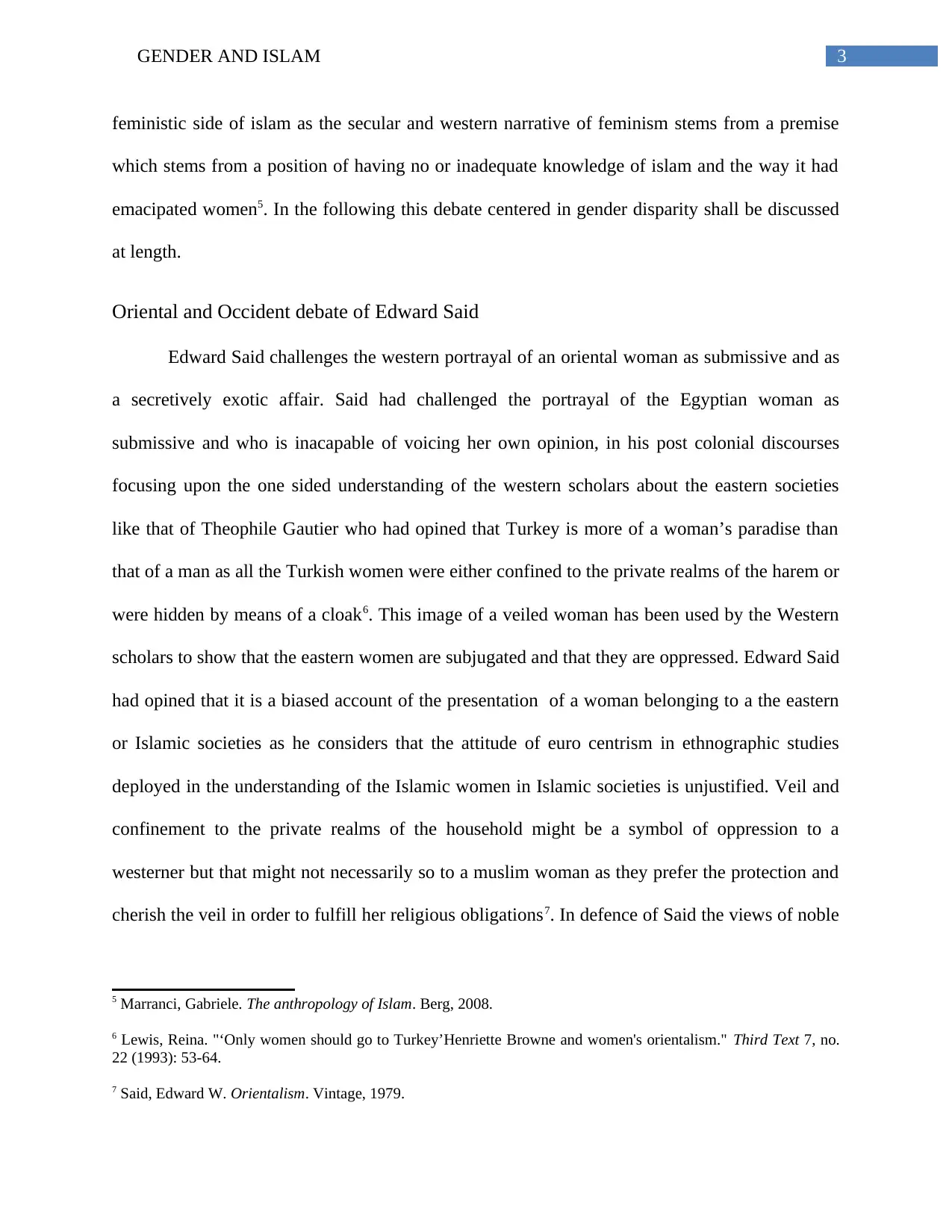
3GENDER AND ISLAM
feministic side of islam as the secular and western narrative of feminism stems from a premise
which stems from a position of having no or inadequate knowledge of islam and the way it had
emacipated women5. In the following this debate centered in gender disparity shall be discussed
at length.
Oriental and Occident debate of Edward Said
Edward Said challenges the western portrayal of an oriental woman as submissive and as
a secretively exotic affair. Said had challenged the portrayal of the Egyptian woman as
submissive and who is inacapable of voicing her own opinion, in his post colonial discourses
focusing upon the one sided understanding of the western scholars about the eastern societies
like that of Theophile Gautier who had opined that Turkey is more of a woman’s paradise than
that of a man as all the Turkish women were either confined to the private realms of the harem or
were hidden by means of a cloak6. This image of a veiled woman has been used by the Western
scholars to show that the eastern women are subjugated and that they are oppressed. Edward Said
had opined that it is a biased account of the presentation of a woman belonging to a the eastern
or Islamic societies as he considers that the attitude of euro centrism in ethnographic studies
deployed in the understanding of the Islamic women in Islamic societies is unjustified. Veil and
confinement to the private realms of the household might be a symbol of oppression to a
westerner but that might not necessarily so to a muslim woman as they prefer the protection and
cherish the veil in order to fulfill her religious obligations7. In defence of Said the views of noble
5 Marranci, Gabriele. The anthropology of Islam. Berg, 2008.
6 Lewis, Reina. "‘Only women should go to Turkey’Henriette Browne and women's orientalism." Third Text 7, no.
22 (1993): 53-64.
7 Said, Edward W. Orientalism. Vintage, 1979.
feministic side of islam as the secular and western narrative of feminism stems from a premise
which stems from a position of having no or inadequate knowledge of islam and the way it had
emacipated women5. In the following this debate centered in gender disparity shall be discussed
at length.
Oriental and Occident debate of Edward Said
Edward Said challenges the western portrayal of an oriental woman as submissive and as
a secretively exotic affair. Said had challenged the portrayal of the Egyptian woman as
submissive and who is inacapable of voicing her own opinion, in his post colonial discourses
focusing upon the one sided understanding of the western scholars about the eastern societies
like that of Theophile Gautier who had opined that Turkey is more of a woman’s paradise than
that of a man as all the Turkish women were either confined to the private realms of the harem or
were hidden by means of a cloak6. This image of a veiled woman has been used by the Western
scholars to show that the eastern women are subjugated and that they are oppressed. Edward Said
had opined that it is a biased account of the presentation of a woman belonging to a the eastern
or Islamic societies as he considers that the attitude of euro centrism in ethnographic studies
deployed in the understanding of the Islamic women in Islamic societies is unjustified. Veil and
confinement to the private realms of the household might be a symbol of oppression to a
westerner but that might not necessarily so to a muslim woman as they prefer the protection and
cherish the veil in order to fulfill her religious obligations7. In defence of Said the views of noble
5 Marranci, Gabriele. The anthropology of Islam. Berg, 2008.
6 Lewis, Reina. "‘Only women should go to Turkey’Henriette Browne and women's orientalism." Third Text 7, no.
22 (1993): 53-64.
7 Said, Edward W. Orientalism. Vintage, 1979.
Paraphrase This Document
Need a fresh take? Get an instant paraphrase of this document with our AI Paraphraser
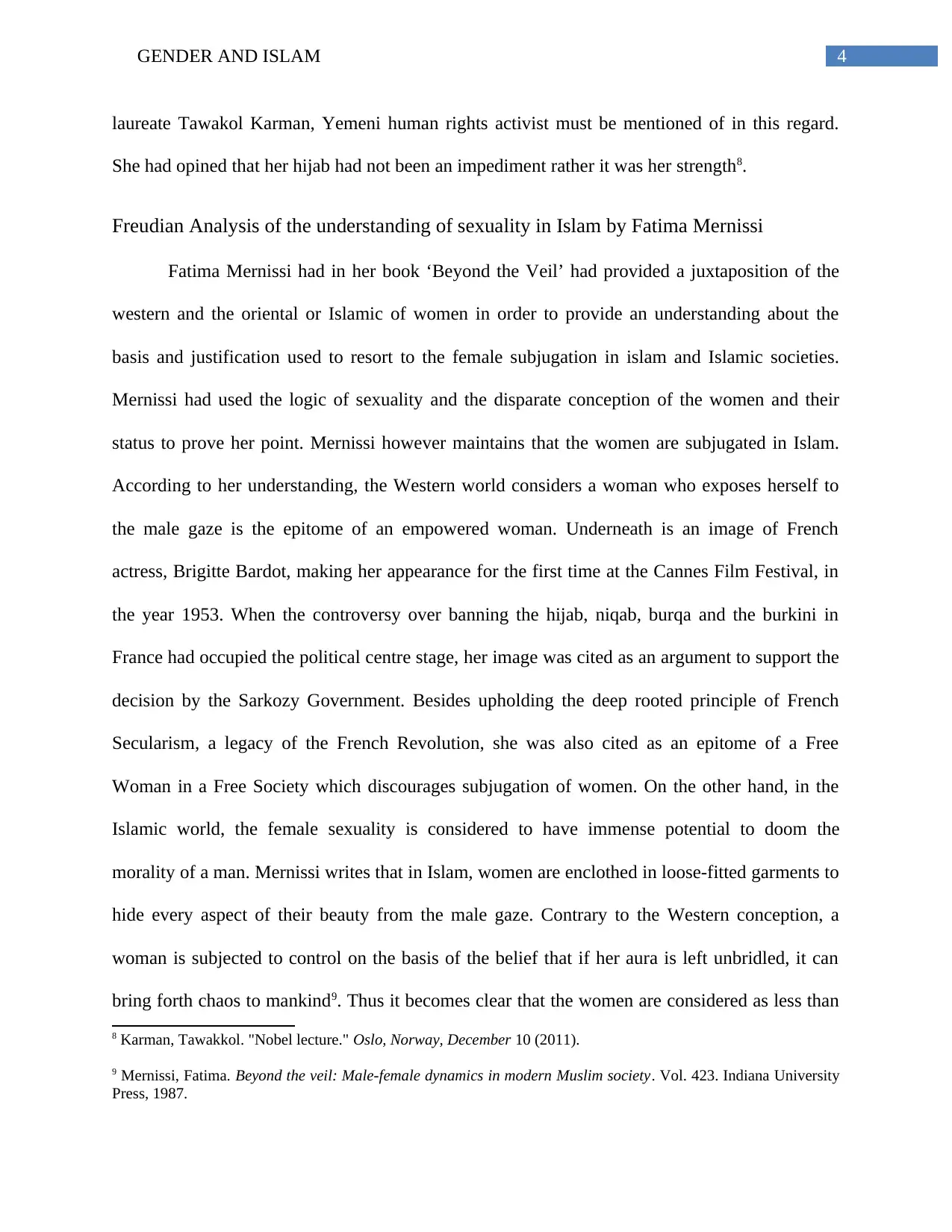
4GENDER AND ISLAM
laureate Tawakol Karman, Yemeni human rights activist must be mentioned of in this regard.
She had opined that her hijab had not been an impediment rather it was her strength8.
Freudian Analysis of the understanding of sexuality in Islam by Fatima Mernissi
Fatima Mernissi had in her book ‘Beyond the Veil’ had provided a juxtaposition of the
western and the oriental or Islamic of women in order to provide an understanding about the
basis and justification used to resort to the female subjugation in islam and Islamic societies.
Mernissi had used the logic of sexuality and the disparate conception of the women and their
status to prove her point. Mernissi however maintains that the women are subjugated in Islam.
According to her understanding, the Western world considers a woman who exposes herself to
the male gaze is the epitome of an empowered woman. Underneath is an image of French
actress, Brigitte Bardot, making her appearance for the first time at the Cannes Film Festival, in
the year 1953. When the controversy over banning the hijab, niqab, burqa and the burkini in
France had occupied the political centre stage, her image was cited as an argument to support the
decision by the Sarkozy Government. Besides upholding the deep rooted principle of French
Secularism, a legacy of the French Revolution, she was also cited as an epitome of a Free
Woman in a Free Society which discourages subjugation of women. On the other hand, in the
Islamic world, the female sexuality is considered to have immense potential to doom the
morality of a man. Mernissi writes that in Islam, women are enclothed in loose-fitted garments to
hide every aspect of their beauty from the male gaze. Contrary to the Western conception, a
woman is subjected to control on the basis of the belief that if her aura is left unbridled, it can
bring forth chaos to mankind9. Thus it becomes clear that the women are considered as less than
8 Karman, Tawakkol. "Nobel lecture." Oslo, Norway, December 10 (2011).
9 Mernissi, Fatima. Beyond the veil: Male-female dynamics in modern Muslim society. Vol. 423. Indiana University
Press, 1987.
laureate Tawakol Karman, Yemeni human rights activist must be mentioned of in this regard.
She had opined that her hijab had not been an impediment rather it was her strength8.
Freudian Analysis of the understanding of sexuality in Islam by Fatima Mernissi
Fatima Mernissi had in her book ‘Beyond the Veil’ had provided a juxtaposition of the
western and the oriental or Islamic of women in order to provide an understanding about the
basis and justification used to resort to the female subjugation in islam and Islamic societies.
Mernissi had used the logic of sexuality and the disparate conception of the women and their
status to prove her point. Mernissi however maintains that the women are subjugated in Islam.
According to her understanding, the Western world considers a woman who exposes herself to
the male gaze is the epitome of an empowered woman. Underneath is an image of French
actress, Brigitte Bardot, making her appearance for the first time at the Cannes Film Festival, in
the year 1953. When the controversy over banning the hijab, niqab, burqa and the burkini in
France had occupied the political centre stage, her image was cited as an argument to support the
decision by the Sarkozy Government. Besides upholding the deep rooted principle of French
Secularism, a legacy of the French Revolution, she was also cited as an epitome of a Free
Woman in a Free Society which discourages subjugation of women. On the other hand, in the
Islamic world, the female sexuality is considered to have immense potential to doom the
morality of a man. Mernissi writes that in Islam, women are enclothed in loose-fitted garments to
hide every aspect of their beauty from the male gaze. Contrary to the Western conception, a
woman is subjected to control on the basis of the belief that if her aura is left unbridled, it can
bring forth chaos to mankind9. Thus it becomes clear that the women are considered as less than
8 Karman, Tawakkol. "Nobel lecture." Oslo, Norway, December 10 (2011).
9 Mernissi, Fatima. Beyond the veil: Male-female dynamics in modern Muslim society. Vol. 423. Indiana University
Press, 1987.
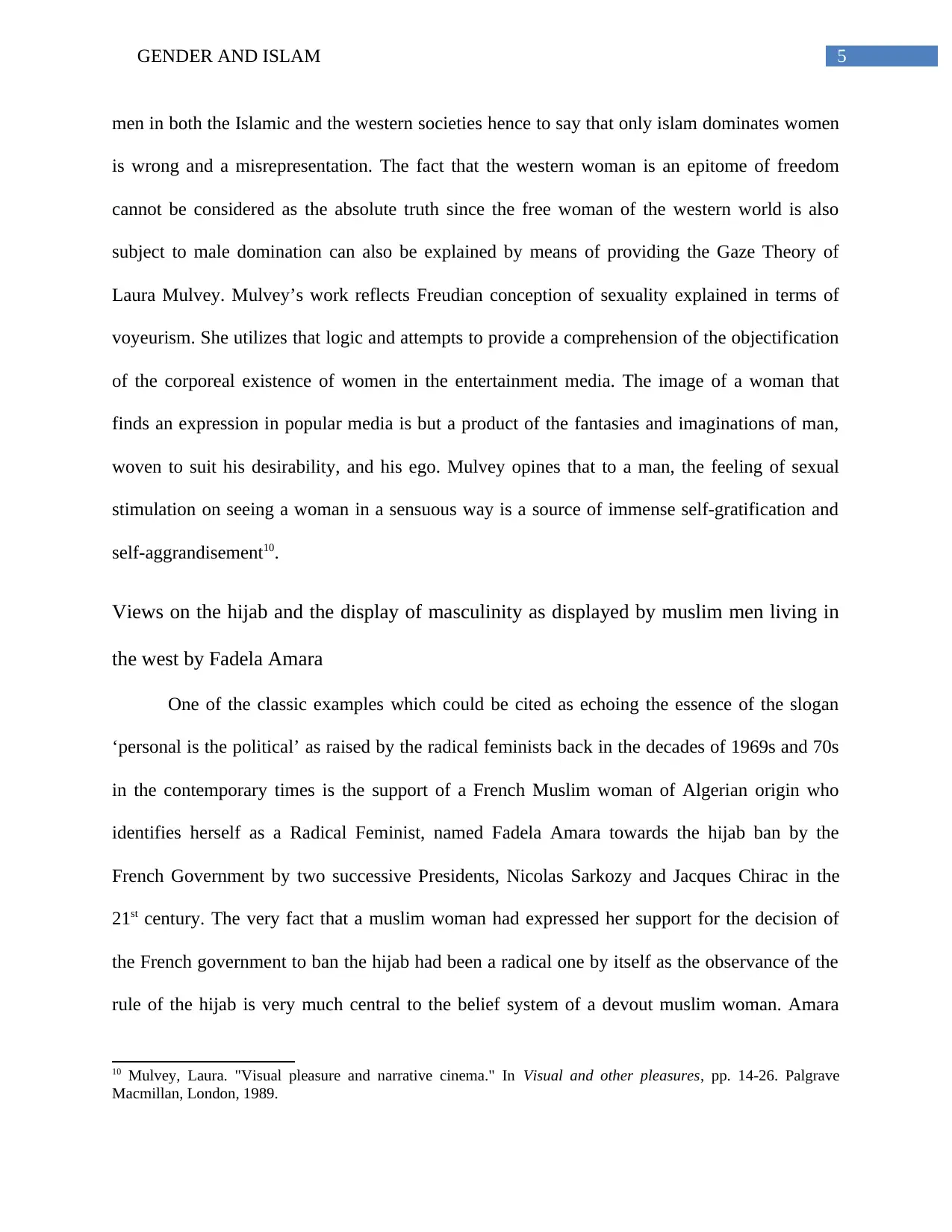
5GENDER AND ISLAM
men in both the Islamic and the western societies hence to say that only islam dominates women
is wrong and a misrepresentation. The fact that the western woman is an epitome of freedom
cannot be considered as the absolute truth since the free woman of the western world is also
subject to male domination can also be explained by means of providing the Gaze Theory of
Laura Mulvey. Mulvey’s work reflects Freudian conception of sexuality explained in terms of
voyeurism. She utilizes that logic and attempts to provide a comprehension of the objectification
of the corporeal existence of women in the entertainment media. The image of a woman that
finds an expression in popular media is but a product of the fantasies and imaginations of man,
woven to suit his desirability, and his ego. Mulvey opines that to a man, the feeling of sexual
stimulation on seeing a woman in a sensuous way is a source of immense self-gratification and
self-aggrandisement10.
Views on the hijab and the display of masculinity as displayed by muslim men living in
the west by Fadela Amara
One of the classic examples which could be cited as echoing the essence of the slogan
‘personal is the political’ as raised by the radical feminists back in the decades of 1969s and 70s
in the contemporary times is the support of a French Muslim woman of Algerian origin who
identifies herself as a Radical Feminist, named Fadela Amara towards the hijab ban by the
French Government by two successive Presidents, Nicolas Sarkozy and Jacques Chirac in the
21st century. The very fact that a muslim woman had expressed her support for the decision of
the French government to ban the hijab had been a radical one by itself as the observance of the
rule of the hijab is very much central to the belief system of a devout muslim woman. Amara
10 Mulvey, Laura. "Visual pleasure and narrative cinema." In Visual and other pleasures, pp. 14-26. Palgrave
Macmillan, London, 1989.
men in both the Islamic and the western societies hence to say that only islam dominates women
is wrong and a misrepresentation. The fact that the western woman is an epitome of freedom
cannot be considered as the absolute truth since the free woman of the western world is also
subject to male domination can also be explained by means of providing the Gaze Theory of
Laura Mulvey. Mulvey’s work reflects Freudian conception of sexuality explained in terms of
voyeurism. She utilizes that logic and attempts to provide a comprehension of the objectification
of the corporeal existence of women in the entertainment media. The image of a woman that
finds an expression in popular media is but a product of the fantasies and imaginations of man,
woven to suit his desirability, and his ego. Mulvey opines that to a man, the feeling of sexual
stimulation on seeing a woman in a sensuous way is a source of immense self-gratification and
self-aggrandisement10.
Views on the hijab and the display of masculinity as displayed by muslim men living in
the west by Fadela Amara
One of the classic examples which could be cited as echoing the essence of the slogan
‘personal is the political’ as raised by the radical feminists back in the decades of 1969s and 70s
in the contemporary times is the support of a French Muslim woman of Algerian origin who
identifies herself as a Radical Feminist, named Fadela Amara towards the hijab ban by the
French Government by two successive Presidents, Nicolas Sarkozy and Jacques Chirac in the
21st century. The very fact that a muslim woman had expressed her support for the decision of
the French government to ban the hijab had been a radical one by itself as the observance of the
rule of the hijab is very much central to the belief system of a devout muslim woman. Amara
10 Mulvey, Laura. "Visual pleasure and narrative cinema." In Visual and other pleasures, pp. 14-26. Palgrave
Macmillan, London, 1989.
⊘ This is a preview!⊘
Do you want full access?
Subscribe today to unlock all pages.

Trusted by 1+ million students worldwide
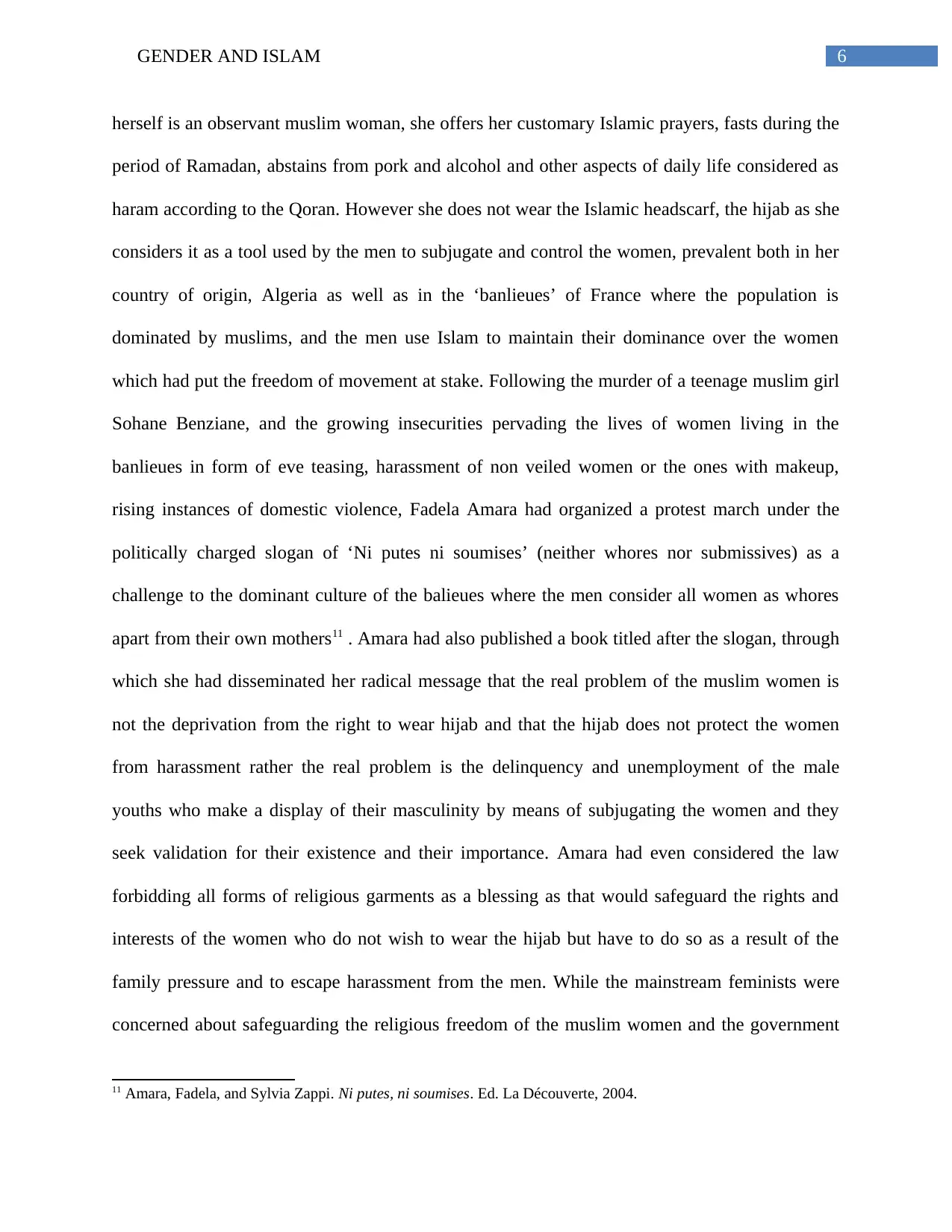
6GENDER AND ISLAM
herself is an observant muslim woman, she offers her customary Islamic prayers, fasts during the
period of Ramadan, abstains from pork and alcohol and other aspects of daily life considered as
haram according to the Qoran. However she does not wear the Islamic headscarf, the hijab as she
considers it as a tool used by the men to subjugate and control the women, prevalent both in her
country of origin, Algeria as well as in the ‘banlieues’ of France where the population is
dominated by muslims, and the men use Islam to maintain their dominance over the women
which had put the freedom of movement at stake. Following the murder of a teenage muslim girl
Sohane Benziane, and the growing insecurities pervading the lives of women living in the
banlieues in form of eve teasing, harassment of non veiled women or the ones with makeup,
rising instances of domestic violence, Fadela Amara had organized a protest march under the
politically charged slogan of ‘Ni putes ni soumises’ (neither whores nor submissives) as a
challenge to the dominant culture of the balieues where the men consider all women as whores
apart from their own mothers11 . Amara had also published a book titled after the slogan, through
which she had disseminated her radical message that the real problem of the muslim women is
not the deprivation from the right to wear hijab and that the hijab does not protect the women
from harassment rather the real problem is the delinquency and unemployment of the male
youths who make a display of their masculinity by means of subjugating the women and they
seek validation for their existence and their importance. Amara had even considered the law
forbidding all forms of religious garments as a blessing as that would safeguard the rights and
interests of the women who do not wish to wear the hijab but have to do so as a result of the
family pressure and to escape harassment from the men. While the mainstream feminists were
concerned about safeguarding the religious freedom of the muslim women and the government
11 Amara, Fadela, and Sylvia Zappi. Ni putes, ni soumises. Ed. La Découverte, 2004.
herself is an observant muslim woman, she offers her customary Islamic prayers, fasts during the
period of Ramadan, abstains from pork and alcohol and other aspects of daily life considered as
haram according to the Qoran. However she does not wear the Islamic headscarf, the hijab as she
considers it as a tool used by the men to subjugate and control the women, prevalent both in her
country of origin, Algeria as well as in the ‘banlieues’ of France where the population is
dominated by muslims, and the men use Islam to maintain their dominance over the women
which had put the freedom of movement at stake. Following the murder of a teenage muslim girl
Sohane Benziane, and the growing insecurities pervading the lives of women living in the
banlieues in form of eve teasing, harassment of non veiled women or the ones with makeup,
rising instances of domestic violence, Fadela Amara had organized a protest march under the
politically charged slogan of ‘Ni putes ni soumises’ (neither whores nor submissives) as a
challenge to the dominant culture of the balieues where the men consider all women as whores
apart from their own mothers11 . Amara had also published a book titled after the slogan, through
which she had disseminated her radical message that the real problem of the muslim women is
not the deprivation from the right to wear hijab and that the hijab does not protect the women
from harassment rather the real problem is the delinquency and unemployment of the male
youths who make a display of their masculinity by means of subjugating the women and they
seek validation for their existence and their importance. Amara had even considered the law
forbidding all forms of religious garments as a blessing as that would safeguard the rights and
interests of the women who do not wish to wear the hijab but have to do so as a result of the
family pressure and to escape harassment from the men. While the mainstream feminists were
concerned about safeguarding the religious freedom of the muslim women and the government
11 Amara, Fadela, and Sylvia Zappi. Ni putes, ni soumises. Ed. La Découverte, 2004.
Paraphrase This Document
Need a fresh take? Get an instant paraphrase of this document with our AI Paraphraser

7GENDER AND ISLAM
of France about safeguarding the constitutional principle of secularism, Amara had through her
radical movement championed the oppression which non conformist muslim women face, who
are marginalized by the muslim community fir their rebellious attitude and also by their fellow
religious muslim women. Amara had brought the concerns of the women which were considered
as personal and hidden to safeguard the family honour to the political forefront by her activism12.
Conclusion
Thus at the end it can be said that the view that gender relations being disparate in islam
cannot be considered as a tool of oppression of women as per the Western narrative as even the
Western societies have their set of flaws and their own subtle method of subjugating women.
Whether a muslim woman is being oppressed or not by the Islamic gender equations must be left
to the judgement of a muslim woman herself, and must be not be attempted to make an objective
reality.
12 Selby, Jennifer A. "French secularism as a ‘guarantor’of women's rights? Muslim women and gender politics in a
Parisian banlieue." Culture and Religion 12, no. 4 (2011): 441-462.
of France about safeguarding the constitutional principle of secularism, Amara had through her
radical movement championed the oppression which non conformist muslim women face, who
are marginalized by the muslim community fir their rebellious attitude and also by their fellow
religious muslim women. Amara had brought the concerns of the women which were considered
as personal and hidden to safeguard the family honour to the political forefront by her activism12.
Conclusion
Thus at the end it can be said that the view that gender relations being disparate in islam
cannot be considered as a tool of oppression of women as per the Western narrative as even the
Western societies have their set of flaws and their own subtle method of subjugating women.
Whether a muslim woman is being oppressed or not by the Islamic gender equations must be left
to the judgement of a muslim woman herself, and must be not be attempted to make an objective
reality.
12 Selby, Jennifer A. "French secularism as a ‘guarantor’of women's rights? Muslim women and gender politics in a
Parisian banlieue." Culture and Religion 12, no. 4 (2011): 441-462.
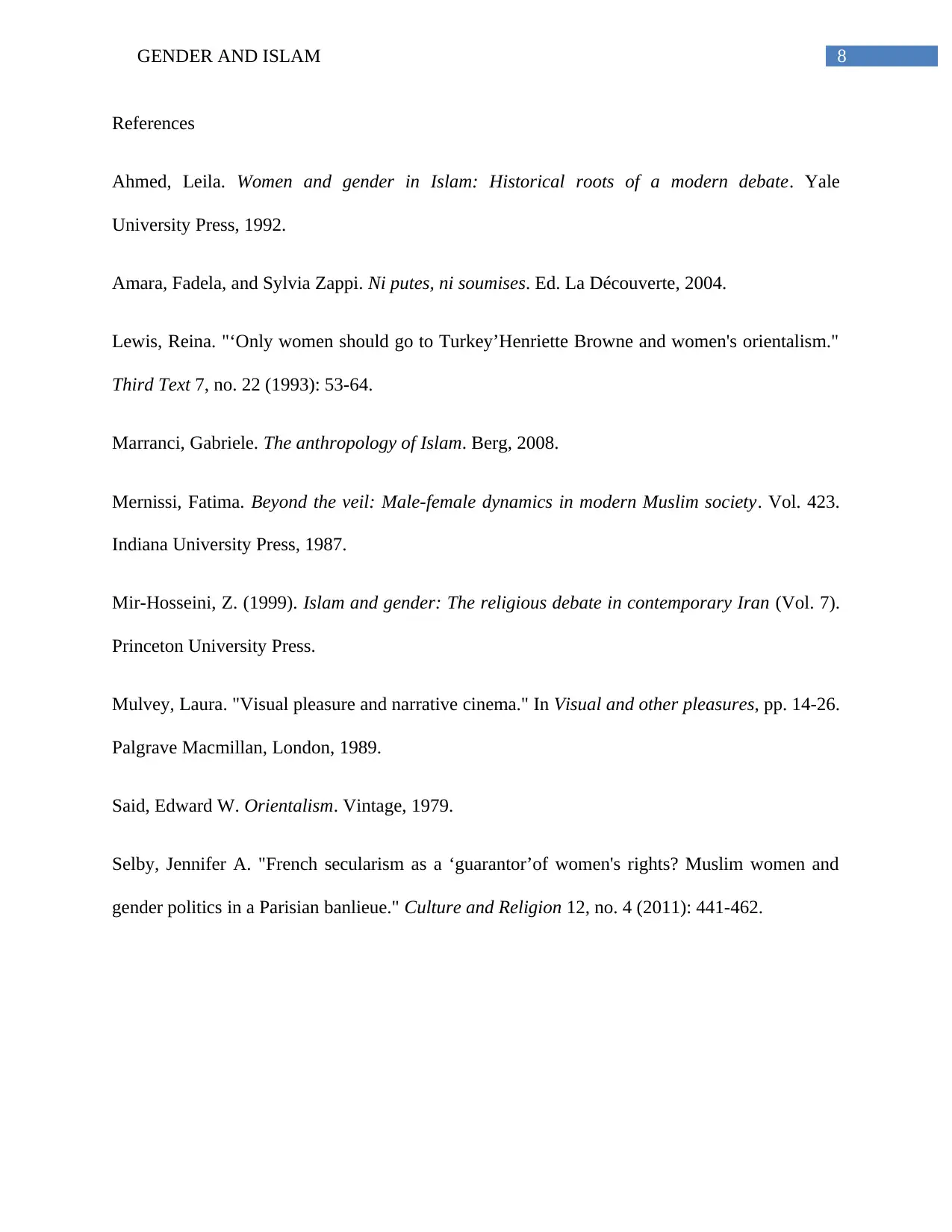
8GENDER AND ISLAM
References
Ahmed, Leila. Women and gender in Islam: Historical roots of a modern debate. Yale
University Press, 1992.
Amara, Fadela, and Sylvia Zappi. Ni putes, ni soumises. Ed. La Découverte, 2004.
Lewis, Reina. "‘Only women should go to Turkey’Henriette Browne and women's orientalism."
Third Text 7, no. 22 (1993): 53-64.
Marranci, Gabriele. The anthropology of Islam. Berg, 2008.
Mernissi, Fatima. Beyond the veil: Male-female dynamics in modern Muslim society. Vol. 423.
Indiana University Press, 1987.
Mir-Hosseini, Z. (1999). Islam and gender: The religious debate in contemporary Iran (Vol. 7).
Princeton University Press.
Mulvey, Laura. "Visual pleasure and narrative cinema." In Visual and other pleasures, pp. 14-26.
Palgrave Macmillan, London, 1989.
Said, Edward W. Orientalism. Vintage, 1979.
Selby, Jennifer A. "French secularism as a ‘guarantor’of women's rights? Muslim women and
gender politics in a Parisian banlieue." Culture and Religion 12, no. 4 (2011): 441-462.
References
Ahmed, Leila. Women and gender in Islam: Historical roots of a modern debate. Yale
University Press, 1992.
Amara, Fadela, and Sylvia Zappi. Ni putes, ni soumises. Ed. La Découverte, 2004.
Lewis, Reina. "‘Only women should go to Turkey’Henriette Browne and women's orientalism."
Third Text 7, no. 22 (1993): 53-64.
Marranci, Gabriele. The anthropology of Islam. Berg, 2008.
Mernissi, Fatima. Beyond the veil: Male-female dynamics in modern Muslim society. Vol. 423.
Indiana University Press, 1987.
Mir-Hosseini, Z. (1999). Islam and gender: The religious debate in contemporary Iran (Vol. 7).
Princeton University Press.
Mulvey, Laura. "Visual pleasure and narrative cinema." In Visual and other pleasures, pp. 14-26.
Palgrave Macmillan, London, 1989.
Said, Edward W. Orientalism. Vintage, 1979.
Selby, Jennifer A. "French secularism as a ‘guarantor’of women's rights? Muslim women and
gender politics in a Parisian banlieue." Culture and Religion 12, no. 4 (2011): 441-462.
⊘ This is a preview!⊘
Do you want full access?
Subscribe today to unlock all pages.

Trusted by 1+ million students worldwide
1 out of 9
Your All-in-One AI-Powered Toolkit for Academic Success.
+13062052269
info@desklib.com
Available 24*7 on WhatsApp / Email
![[object Object]](/_next/static/media/star-bottom.7253800d.svg)
Unlock your academic potential
Copyright © 2020–2025 A2Z Services. All Rights Reserved. Developed and managed by ZUCOL.